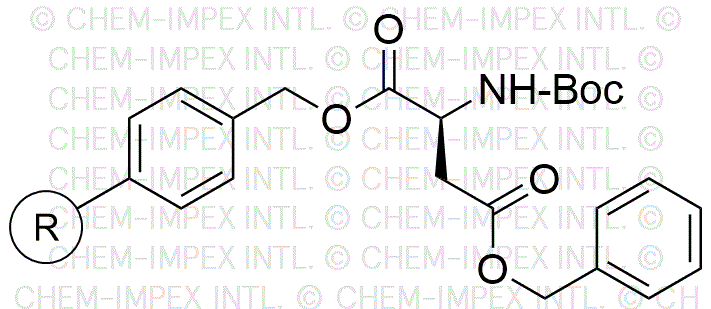Boc-L-aspartic acid b-benzyl ester Merrifield is widely utilized in research focused on:
- Peptide Synthesis: This compound serves as a key building block in the synthesis of peptides, allowing researchers to create complex structures for pharmaceutical development.
- Drug Development: Its unique properties make it valuable in the design of drug candidates, particularly in targeting specific biological pathways, enhancing efficacy and reducing side effects.
- Bioconjugation: The compound is used in bioconjugation processes, linking biomolecules to drugs or imaging agents, which is crucial for targeted therapies in cancer treatment.
- Research in Neuroscience: It plays a role in studying neurotransmitter pathways, aiding in the development of treatments for neurological disorders.
- Material Science: The compound can be incorporated into polymeric materials, enhancing their properties for applications in drug delivery systems and biomaterials.
Informations générales
Propriétés
Sécurité et réglementation
Applications
Boc-L-aspartic acid b-benzyl ester Merrifield is widely utilized in research focused on:
- Peptide Synthesis: This compound serves as a key building block in the synthesis of peptides, allowing researchers to create complex structures for pharmaceutical development.
- Drug Development: Its unique properties make it valuable in the design of drug candidates, particularly in targeting specific biological pathways, enhancing efficacy and reducing side effects.
- Bioconjugation: The compound is used in bioconjugation processes, linking biomolecules to drugs or imaging agents, which is crucial for targeted therapies in cancer treatment.
- Research in Neuroscience: It plays a role in studying neurotransmitter pathways, aiding in the development of treatments for neurological disorders.
- Material Science: The compound can be incorporated into polymeric materials, enhancing their properties for applications in drug delivery systems and biomaterials.
Documents
Fiches de données de sécurité (FDS)
La FDS fournit des informations de sécurité complètes sur la manipulation, le stockage et l’élimination du produit.
Spécifications du produit (PS)
Le PS fournit une description complète des propriétés du produit, notamment sa composition chimique, son état physique, sa pureté et les exigences de stockage. Il détaille également les plages de qualité acceptables et les applications prévues du produit.
Certificats d'analyse (COA)
Recherchez des certificats d'analyse (COA) en saisissant le numéro de lot du produit. Les numéros de lot et de lot se trouvent sur l'étiquette d'un produit, après les mots « Lot » ou « Lot de fabrication ».
Numéro de catalogue
Numéro de lot/série
Certificats d'origine (COO)
Ce certificat d'exploitation confirme le pays dans lequel le produit a été fabriqué, et détaille également les matériaux et composants utilisés et s'il est issu de sources naturelles, synthétiques ou autres sources spécifiques. Ce certificat peut être requis pour les douanes, le commerce et la conformité réglementaire.
Numéro de catalogue
Numéro de lot/série
Fiches de données de sécurité (FDS)
La FDS fournit des informations de sécurité complètes sur la manipulation, le stockage et l’élimination du produit.
DownloadSpécifications du produit (PS)
Le PS fournit une description complète des propriétés du produit, notamment sa composition chimique, son état physique, sa pureté et les exigences de stockage. Il détaille également les plages de qualité acceptables et les applications prévues du produit.
DownloadCertificats d'analyse (COA)
Recherchez des certificats d'analyse (COA) en saisissant le numéro de lot du produit. Les numéros de lot et de lot se trouvent sur l'étiquette d'un produit, après les mots « Lot » ou « Lot de fabrication ».
Numéro de catalogue
Numéro de lot/série
Certificats d'origine (COO)
Ce certificat d'exploitation confirme le pays dans lequel le produit a été fabriqué, et détaille également les matériaux et composants utilisés et s'il est issu de sources naturelles, synthétiques ou autres sources spécifiques. Ce certificat peut être requis pour les douanes, le commerce et la conformité réglementaire.

